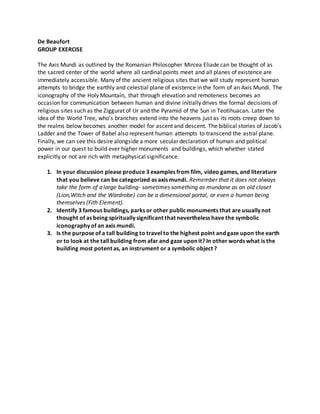Axis Mundi group exercise DEBEAUFORT
- 1. De Beaufort GROUP EXERCISE The Axis Mundi as outlined by the Romanian Philosopher Mircea Eliade can be thought of as the sacred center of the world where all cardinal points meet and all planes of existence are immediately accessible. Many of the ancient religious sites that we will study represent human attempts to bridge the earthly and celestial plane of existence in the form of an Axis Mundi. The iconography of the Holy Mountain, that through elevation and remoteness becomes an occasion for communication between human and divine initially drives the formal decisions of religious sites such as the Ziggurat of Ur and the Pyramid of the Sun in Teotihuacan. Later the idea of the World Tree, who’s branches extend into the heavens just as its roots creep down to the realms below becomes another model for ascent and descent. The biblical stories of Jacob’s Ladder and the Tower of Babel also represent human attempts to transcend the astral plane. Finally, we can see this desire alongside a more secular declaration of human and political power in our quest to build ever higher monuments and buildings, which whether stated explicitly or not are rich with metaphysical significance. 1. In your discussion please produce 3 examples from film, video games, and literature that you believe can be categorized as axis mundi. Remember that it does not always take the form of a large building- sometimes something as mundane as an old closet (Lion,Witch and the Wardrobe) can be a dimensional portal, or even a human being themselves (Fith Element). 2. Identify 3 famous buildings, parks or other publicmonuments that are usually not thought of as being spiritually significant that nevertheless have the symbolic iconography of an axis mundi. 3. Is the purpose of a tall building to travel to the highest point and gaze upon the earth or to look at the tall building from afar and gaze upon it? In other words what is the building most potent as, an instrument or a symbolic object ?

